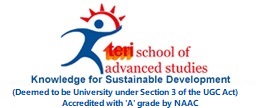
ANNOUNCEMENTS

| Date | News Title | Source |
| 18-July-2025 | 1 in 4 Indian married couples ... | The Indian Express |
| 23-June-2025 | Blended Learning: Driving educ... | The Pioneer |
| 22-June-2025 | All adults overweight in every... | |
| 21-June-2025 | TERI SAS Nurturing Global Sust... | The Interview World (Online) |
| 27-May-2025 | Eco-education trend grows: Sus... | India Today (Online- Education Desk) |
| 25-March-2025 | How water green credits can fu... | Hindustan Times (Opinion) |
| 23-February-2025 | Sustainable biz practices disc... | The Times of India (Online) |
| 21-February-2025 | Sangam fit for bath’, Enviro... | News9 (Online) |
| 12-February-2025 | A role for India in South-Sout... | The Hindu (Online) |
| 02-December-2024 | ICAR Findings Show 34% Decline... | ETV Bharat (Online) |
Awaiting an environment management plan (EMP) for the Najafgarh Jheel from the Haryana government for over 10 months, the National Green Tribunal (NGT) ordered the chief secretary of Haryana to be present for the next hearing, scheduled for October 10, along with the status of compliance.
On June 17, the principal bench of NGT, headed by chairperson justice AK Goel, while hearing a petition filed by the Indian National Trust for Art & Cultural Heritage (Intach) for the protection of the water body, said, “We have considered the matter and find that the issue of restoration of water body in question is significant for the environment but has not received the attention it requires from the authorities. The State of Haryana has neither prepared EMP nor given any explanation for not doing so. None appears for the State of Haryana...”
“In these circumstances, we consider it necessary to direct chief secretaries of Haryana and Delhi to coordinate with the concerned departments to ensure further remedial action expeditiously and to remain present in person by video conference on the next date with the status of compliance,” stated the order, a copy of which is with HT.
While the Delhi government has submitted a draft EMP, officials from the state environment department said that several committees have been formed to look into the matter and the state will be able to give a response to NGT by the next hearing.
RK Chauhan, the joint director of state environment, said, “We have been working in this matter continuously and reports of the technical committee formed to study the matter have been submitted. In our case, we have a lot of area around the lake which falls under different categories like private land, agricultural land. At present, deliberations are underway regarding the area of the lake and we should be able to reach a conclusion by July-end after which an environment management plan will be devised.”
The seven-square kilometre water body is important for Gurugram as it acts as a large aquifer to recharge groundwater. Many creeks in the Aravallis flow into the Najafgarh Jheel, which is further carried to the Yamuna.
Akash Vashishtha, the advocate for the petitioner, said, “While Delhi has prepared the draft EMP, the Haryana government made no response in compliance with the NGT’s directions from September 19, 2020. The Najafgarh Jheel is a natural hazard zone, as it falls in Seismic Zone-IV and is also the highest zone of soil liquefaction. The two factors, if combined, would be catastrophic to people’s lives and property. Despite that, the Haryana government and its agencies are allowing high-rise constructions near the water body.”
Experts privy to the details of the draft EMP prepared by the Delhi government said that the same can be adopted by the Haryana government.
Ritu Rao, a PhD scholar at the TERI School of Advanced Studies, who specialises and works on urban water bodies, said that protecting the Najafgarh Jheel can help solve problems of both water scarcity and waterlogging in the city. “To address the issues of water scarcity and flooding in Gurugram, we need to restore the existing hydrological channel and water bodies in Gurugram. Haryana should declare Najafgarh Jheel a wetland up to contour 212.5 metres above mean sea level, in accordance with the high flood level of the past 100 years in the area. If this is not complied with, there is always a risk of flooding and collapsing of buildings constructed on this wetland,” said Rao.
Objectives of Draft EMP prepared by Delhi
Land use and land cover of the wetland is maintained in line with regulatory requirements under Wetland Rules 2017, and in accordance with master plans of NCT of Delhi and Gurugram
Efficient treatment of sewage received within the wetland
Maintenance of diversity of biota within Najafgarh Jheel
Participation of wetland communities in management plan implementation and affirmative behaviour change within community
Systematic wetland inventory, assessment and monitoring system is used to inform management decisions and assess effectiveness
Integration of multiple values of wetland in sectoral development planning to be enhanced
Restoration of wetland habitat and removal of invasive species
Plot No. 10, Institutional Area, Vasant Kunj, New Delhi - 110 070, India.
Tel. +91 11 71800222 (25 lines).
Website : www.terisas.ac.in
Email id : registrar@terisas.ac.in
© Copyright © 2025, TERI SAS, All rights reserved.
Visitors No.: 46511698 Since 2023


